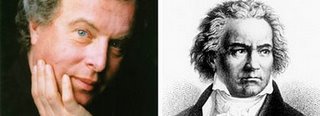Last night, András Schiff wrapped up his complete cycle of Beethoven sonatas. Henry Schlinger, who has attended the recitals since the musical event began at Disney Hall in Fall 2007, provides a closing review.

Andras Schiff and Beethoven
On Wednesday, April 1, pianist András Schiff concluded his two-season odyssey through the complete Beethoven piano sonatas at Disney Hall with mesmerizing performances of the Op. 109, Op. 110, and Op. 111 sonatas.
In his last recital, perhaps more than any of the previous ones, Schiff became Beethoven, demonstrating not only the technical prowess necessary to play these pieces, but, much more rare, the intellectual and emotional understanding of the sonatas. As with the recital on March 25, Schiff played these three sonatas without intermission in a program that lasted only a little more than an hour. But what an hour it was.
It is difficult to describe Beethoven’s 32 piano sonatas without using superlatives. Collectively, they may be the greatest single musical achievement in Western music — although the Mozart piano concertos and the Haydn string quartets may be a close second. Many of the sonatas are masterpieces in their own right, and the Op. 109-111 certainly stand on their own as pillars of the art form. But one probably cannot fully appreciate them either individually or as a group unless one is familiar with the 29 that preceded them.
Beethoven was a bit like Picasso; he continuously redefined himself in his music. He wrote revolutionary symphonies, concertos, string quartets, and, of course, piano sonatas. But Beethoven had to define what was revolutionary for himself because he had no contemporary equals and therefore could only rebel against his own musical standards. So it is with these last six sonatas, especially the last three. In each, Beethoven includes movements that are stripped down to their bare essentials with simple, controlled melodic lines that seem more appropriately written for voice and chordal accompaniment. In the Op. 109 and Op. 110 sonatas, the first movements end on the quietest piano and are immediately followed by dramatically contrasting second movements that display what Schiff described in a conversation with Martin Meyer as “demonically agitated energy” and “boisterous anger,” respectively. There are large intervals between the lowest bass and the highest treble keys. There are instances of contrapuntal writing and fugues, most notably in the third movement of the Op. 110, harking back to Bach and Handel. And there are sections in all three sonatas that are downright hymn-like, maybe because he was simultaneously working on his “Missa Solemnis” (Solemn Mass).
Schiff said to Meyer that his favorite movement in all 32 sonatas is the third (theme and variations) movement of the Op. 110. It’s hard to disagree with him on this, although my preference is for the second and final movement of the Op. 111. And it’s not just because it is the concluding movement of all the 32 sonatas. The movement is also a set of variations in C major (in contrast with the dramatic and fateful key of C minor [like the Fifth Symphony] in the first movement), including one that incorporates a jazzy rhythm. But the variations dissolve and the remainder of the movement is characterized by pure sonority, including trills and double trills at the piano’s high registers that become ethereal (and anticipate Ravel and Debussy) before concluding with a simple C major chord — a fitting conclusion not only for this monumental sonata, but for all 32.
I wished that after each sonata, especially the Op. 109 and Op. 111, the audience wouldn’t have applauded for at least a few minutes so as not to disturb the profound and solemn mood. I know that Schiff agrees because he said to Meyer about the Op. 109: “After a conclusion of that kind, applause should really not be allowed.” One could tell that Schiff felt this way because in the Op. 109 and Op. 111 sonatas, both of which conclude very quietly, Schiff left his hands on the keyboard for several seconds after the last notes sounded. Unfortunately, at the conclusion of the Op. 111, the applause began before Schiff’s hands left the keyboard, but quickly subsided when he didn’t move his hands. It was clear that Schiff was still in the throes of the emotional struggle of not only that sonata but the totality of the three together and perhaps of all 32 he had performed over the last two seasons. This also explains why, despite a standing ovation and several curtain calls, Schiff did not include an encore. What, after all, can follow these three sonatas?






Thank you for this review. My wife and saw the last two concerts up here in San Francisco, and the Chronicle didn’t even run a review. Incredible concerts. The audience started clapping at the end of 32 despite Schiff’s stillness at the keyboard. Also here, no encore after #32, but the week before, three delightful encores.